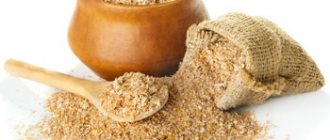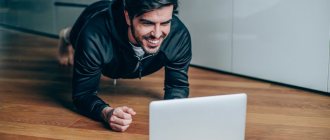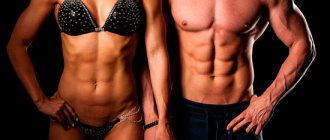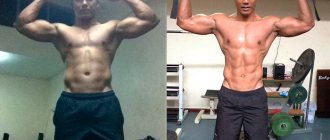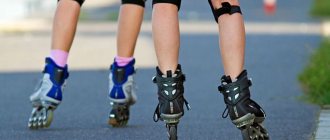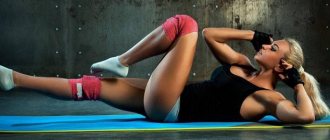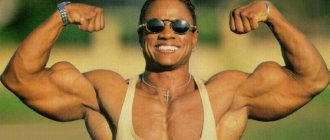Monitoring progress is very important in bodybuilding, be it a professional or amateur version of the sport. You can measure body fat percentage, study body composition, or obtain information in other ways, but the most reliable is a regular centimeter. Correct body measurements will tell you how training progress is built, when you need to specialize in certain muscle groups, and eliminate imbalances. In the end, it's just nice to track your progress using some clear criteria.
It is important for competing bodybuilders to know their weight, because there are weight categories in sports. Hobbyists can track muscle gain or weight loss in the same way. Weighing is simple. You need to weigh yourself on a scale in the morning on an empty stomach, wearing or without the same clothes. Gaining half a pound in weight shouldn't be frustrating, even if you're losing weight. These weight fluctuations are normal and may be related to diet, fluid retention, or other factors. A greater role is played by how much the muscles increase in volume and how the fat layer decreases. And this can be assessed either visually from a photo or from body measurements with a centimeter tape. Old school coaches recommend the centimeter, as it is an objective criterion of progress.
How often should measurements be taken?
It is enough to measure body circumference once every few weeks. If you take such measurements more often than once every two weeks, you simply will not notice a significant difference in the numbers. After all, muscles don't grow that fast. The basic rule for measuring body girth is that they should be carried out as equally as possible, measuring in the same place, and also trying to measure as objectively as possible, without deceiving yourself.
Other ways to determine training effectiveness
- For those involved in strength training, results can also be recorded based on the number of approaches, repetitions and weights lifted. But all this data must be recorded in a training diary, otherwise you will not be able to monitor your progress.
- For those who develop endurance, it would be useful to record the time spent covering distances, the number of contractions of the heart muscle and the distance covered. All this data also needs to be recorded in your training diary in order to clearly see your achievements.
- And the last method for today is a photo diary,
in principle, it is a good alternative to body measurements. Every month you take three photographs (primary) of your body, without clothes - front, back and side. But you need to constantly take photographs from the same distance and angle, otherwise the training results will not be accurate. As a result, by comparing photographs over several months, you will be able to see the difference not only in numbers, but also externally from the photographs. In this method, you can choose which part of the body to photograph, this will not interfere in any way, but on the contrary...
How to take measurements correctly
Take body measurements in the morning, immediately after visiting the toilet. Measuring at the end of the day is not entirely correct, since there may be slight swelling of the legs, as well as an increase in body weight due to food eaten during the day. It is not recommended to take measurements immediately after strength training, when the muscles increase in volume due to blood flow. Such measurements are more of a self-deception than a recording of your real result.
Wrist
Position and Condition: Bend your elbow for easy measurement. The hand is relaxed. Measurement location: a little further from the hand, in the thinnest part of the forearm.
Forearm
Position and condition: bend your arm at the elbow (the angle between the forearm and biceps is about 90 degrees), clench your hand into a fist and bend your fist towards the forearm to an angle of 90 degrees. All arm muscles are tense; It is important to strain only the internal muscles of the forearm (we bent the hand in their direction), but also the external muscles. Measurement location: the widest part of the forearm, 1-2 cm away from the transition to the shoulder.
Hand
Position and condition: bend your arm at the elbow (the angle between the forearm and shoulder is about 70 degrees). All arm muscles are tense; we strain both the biceps and triceps, and not just the biceps in isolation. Measurement location: the widest part of the arm, approximately the middle of the biceps or the place of its peak (if there is one).
Neck
Position and condition: stand straight, chin raised. The neck is relaxed. Measurement location: just above the base of the neck and just below the level of the Adam’s apple.
Shoulder girdle
Position and condition: stand straight, shoulders slightly back, arms down. All muscles of the shoulder girdle and back are relaxed. Measuring location: the measuring tape should pass through the middle of the deltoid muscles, the top of the chest and along the shoulder blades.
Breast
Position and condition: stand straight, breathe moderately (without active inhalations and exhalations). The torso is completely relaxed. Measurement location: the widest part of the chest, approximately at nipple level.
Waist/Belly
Position and condition: stand straight, breathe moderately (without active inhalations and exhalations). The abdomen is statically tense - we do not relax it on purpose, but we also do not contract the abdominal muscles. Measurement location: approximately the middle of the abdomen, just above the level of the navel (waist), just below the level of the navel (side).
Pelvis
Position and condition: stand straight. The gluteal muscles are relaxed. Measurement location: the widest part of the pelvis, approximately the middle of the gluteal muscles.
Hip
Position and condition: stand straight, keep the main support on the leg that you are measuring. The knee joint is straightened as much as possible, the thigh muscles are tense. Measurement location: the widest part of the thigh, usually located at the very top, approximately 5-7 cm below the transition of the thigh to the pelvis.
Shin
Position and condition: Measure your lower leg while sitting. Tighten the muscles of your lower leg by standing on your toes and transferring part of the load, as if you were leaning not only with your pelvis on a chair, but also with your feet on the floor. Measurement location: the widest part of the lower leg, usually 5-7 cm below the transition point of the lower leg into the thigh.
Ankle
Position and condition: Measure your ankle while sitting. The leg is relaxed. Measurement location: just above the beginning of the foot, in the thinnest part of the lower leg.
Ideal symmetry parameters
In order to get closer to the maximum harmonious ratio of different parts of the body, there is a special system of measures called the “golden ratio”. The modern system of body measurements, based on the “golden ratio”, helps to calculate the proportions of a person’s figure that are worth striving for.
- neck circumference should be about 38 percent of chest circumference;
- The circumference of the forearm is ideally 30% of the circumference of the chest;
- the waist should be equal to 75% of the chest circumference;
- pelvic circumference is equal to 0.9 of the chest circumference;
- hip circumference should be 60% of pelvic circumference;
- the lower leg is equal to 40% of the pelvic girth;
- The girth parameters of the calves, biceps and neck should be equal or almost equal to each other.
Compliance with the listed proportions can make an athlete’s figure very close to ideal. However, achieving such indicators cannot be called an easy process: often different muscle groups have different growth dynamics. An individual nutrition and training program drawn up by an experienced trainer will help you cope with this imbalance.
Don't miss interesting news and events in the telegram channel: https://tlgg.ru/fitbarnews
How to measure your fat level?
An important part of body measurements is measuring your body fat percentage. Measuring this level will show whether your weight is gaining or losing weight - due to muscle or fat tissue. To measure the level of fat in the body, you can use either mechanical devices (for example, a plastic clamp - caliper), or special electronic devices or scales with a body composition analyzer.
The first method is weighing.
The simplest and most regular thing that all people involved in sports do is weigh themselves.
. It is necessary to monitor your weight, but you cannot rely on this indicator alone. Since when losing weight, a situation may arise that you, on the contrary, will gain a little weight, but this weight will not be gained by adding fat, but by increasing muscle mass. However, as is correct, this is a very low probability, since when you dry out (lose weight), your caloric intake decreases, and for muscle growth, on the contrary, you need to increase caloric intake (excess). Although this also happens - weight increases (body weight and volume), but not due to the increase in muscle tissue, but due to the appearance of excess subcutaneous fat or vice versa...
Basic rules for weighing:
- You need to weigh yourself every week, at the same time and on the same day of the week.
- You need to weigh yourself after using the toilet and before breakfast.
But in order for the picture to be more complete, in addition to weighing, you should take measurements of body volumes and measurements of fat folds using a caliper, because only then will you track your achievements and body changes over time (as correctly as possible). You can learn more about measuring subcutaneous fat in the article: How to measure subcutaneous fat.
Cushion surface
Most orthopedic pillows have a smooth surface, but there are products with fine perforations and a cellular surface. This surface has a micro-massage effect and creates better air circulation, which creates more comfortable sleeping conditions, and also helps slow down the appearance of wrinkles and aging of the facial skin and collar area. Choosing the type of surface is simple - it’s better to buy what you like best.
A correctly chosen orthopedic pillow will not only give you a sound sleep and a feeling of vigor in the morning, but will also contribute to the prevention and treatment of diseases of the cervical spine. Although osteochondrosis and other diseases, various deformities, injuries and other pathologies of the cervical spine require a complex of medical measures - massage, manual therapy, drug treatment, nevertheless, a properly selected pillow will help relieve pain and improve overall well-being.
Realistic goals
Joe Roak suggests following this rule: “To determine arm potential, multiply your wrist circumference in inches by 2.3.”
For example, if the wrist size is 7 inches (17.78 cm), then multiplying by 2.3 we get 16 inches (about 40 cm). You say, who would want to have 16-inch arms? Believe me, skinny 16-inch arms look bigger than they actually are.
Among the Gainesville athletes, only one had arms larger than 16 inches (Craig Holaday). Moreover, you must reach 16 inches first before moving on. If you already have an arm at a full 16 inches, then your goal should be 17 inches, and if it is 17, then your goal should be 18 inches. Be realistic and move towards the final result gradually.
The importance of correct measurements
In many situations, taking measurements requires careful monitoring, because every unaccounted centimeter can cause many problems in the future associated with tailoring clothes according to incorrect data.
Almost every woman faces this situation when choosing a wedding dress. In this case, as a rule, they trust a professional receptionist, but absolutely any woman can easily understand how to correctly measure body volumes on her own.
Determination of forefoot abduction
Body measurements for weight loss. table on how to do it correctly
Forefoot abduction (abduction) is determined by outlining the external contours of the foot under study. The outlines of the ankles are also outlined. After this, connect the most protruding parts of the contours of the ankles with a straight line. The axis of a normal foot passes through two points: through the middle of the tip of the second toe and the middle of the bimaleolar line. If we continue the axis of the foot towards the heel, then with a normal structure of the foot most of the outlined heel is located medially from the axis of the foot. The axis of the foot forms an angle less than a right angle with the bimaleolar line. With a flat (pronated) foot, this angle is greater than a right angle, which indicates the presence of abduction of the forefoot; the magnitude of the deviation angle gives an idea of the severity of abduction. By the location of the axis on the outlined contour of the heel, you can determine the degree of pronation of the hindfoot. All foot measurements must be taken symmetrically on both legs.
Selection of clothing according to weight groups
There are 4 standard groups that reflect the completeness of a person. They are determined by finding the difference between the volume of the chest and hips. Having found the difference between the indicators, you can easily calculate which group you belong to:
- 1st – 4 cm;
- 2nd – 8 cm;
- 3rd – 12 cm;
- 4th – 16 cm.
For girls who belong to groups 3 and 4, it is better to buy “separated” sets, that is, in which the top and bottom will be separate. Moreover, the bottom should be larger, since their figures are considered non-standard.
Summarize
So we looked at the topic: How to take body measurements correctly. And how to determine the results of training?
Based on this, it becomes clear that in any sport it is necessary to analyze and compare the results, but if this is not done, then you will simply “stand still” and not progress. For this very reason, all athletes attach great importance to monitoring their achievements. After all, if you scrupulously monitor any process, then in the end you will learn to manage it (results).
Exercise, eat right and get better - good luck to you.
European size charts for men's clothing
European manufacturers have their own designations for men's clothing sizes, which are sometimes difficult to understand, but after studying the table, it will be much easier to navigate the sizes of foreign manufacturers.
Size markings
Clothing sizes from European manufacturers
Wrist and forearm blood pressure monitors
Measuring hand grip force norm table
Our readers successfully use ReCardio to treat hypertension. Seeing how popular this product is, we decided to bring it to your attention. Read more here...
When choosing a tonometer, a person draws up a certain number of criteria that the device for measuring pressure must meet. A potential buyer has a choice between devices with a wrist or shoulder mount. Each model has its pros and cons. Among the main characteristics are measurement accuracy, compactness, appearance, and ease of use outside the home.
Tonometer on the forearm
Tonometers with a sleeve attached to the shoulder are recommended for older people, since such automatically controlled tonometers are much more comfortable to use.
This feature is due to the fact that, unlike the carpal vessels, the brachial vessels are larger, so blood circulation and heart rate are felt better on the shoulder. In people with chronic diseases of the blood vessels, measurements are more difficult, as the vessels become denser, which affects the quality of the signal and the reliability of the data obtained. Heart disease may also affect the reliability of your results.
Such features of the body require modern instruments, where the device takes measurements several times in a row, after which it shows the user the average value. Such devices also have additional functions:
- indicate disturbances in heart rhythm and interruptions in heart contractions;
- have a reminder function for scheduled measurements;
- save the results of previous measurements, including date and time.
Wrist blood pressure monitor
A wrist tonometer is a small and fully automatic device that is mounted on the wrist. Blood pressure is measured at the radial artery at the junction of the forearm and hand bones. The mechanism of operation is similar to the action of a shoulder tonometer. This type of device is convenient to use at home, as it does not require special skills. The compactness and lightness of the device allow you to comfortably use the wrist tonometer outside the home, at work or while traveling.
Wrist blood pressure monitors are not very popular, as there is an opinion that they do not give an accurate result.
Despite the obvious advantages, the device has a noticeable drawback. Most wrist-mounted devices produce insufficiently accurate results and have a large error. Often, a person can see a normal pressure reading when complications of arterial hypertension or high blood pressure have begun, when in reality the parameters are normal.
To improve the accuracy of the device’s readings, it is necessary to hold the hand on which the tonometer is attached in the area of the heart. It is worth considering that a difference in the position of the hand (even by a few centimeters) can introduce an error in the study results (up to 10 mm Hg). If you place the tonometer much higher than the position of the heart, the study indicators will be distorted in a higher direction; if lower, then in a lower direction
It is possible to measure blood pressure in a supine position, but even in this case it is important to ensure that the device on the arm is in the area of the heart
What to choose?
Since there is a large error in monitoring, experts do not recommend using this kind of devices for systematic monitoring or self-monitoring of pressure. To carry out regular measurements without visiting your doctor, it is better to opt for an automatic or semi-automatic device with a sleeve attached to the shoulder.
Some tips
- Don’t be too scared or worried if the weight suddenly “goes up” or the muscles stop growing. In both cases, you need to reconsider your training program and diet. You will learn more about nutrition for weight loss and muscle growth in the section Proper nutrition.
- There can also be many reasons why muscle mass stops growing. Some of the main ones are: lack of nutrients (energy), lack of recovery, no progression of load, poor exercise technique and your energy system is not yet ready for further growth, so it needs to be further developed (train regularly and follow the training program). If you are all If you analyze this, you will find what your problem of stagnation (plateau) is.
- It is quite possible that the weight that quickly escaped decided to settle on your sides and waist again just because a series of holidays passed in your life, and your diet was slightly disrupted. Or maybe you were sick or worked very hard, so you had no time for training.
